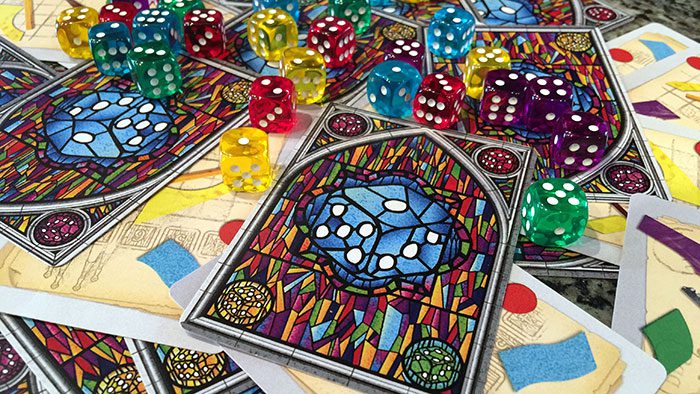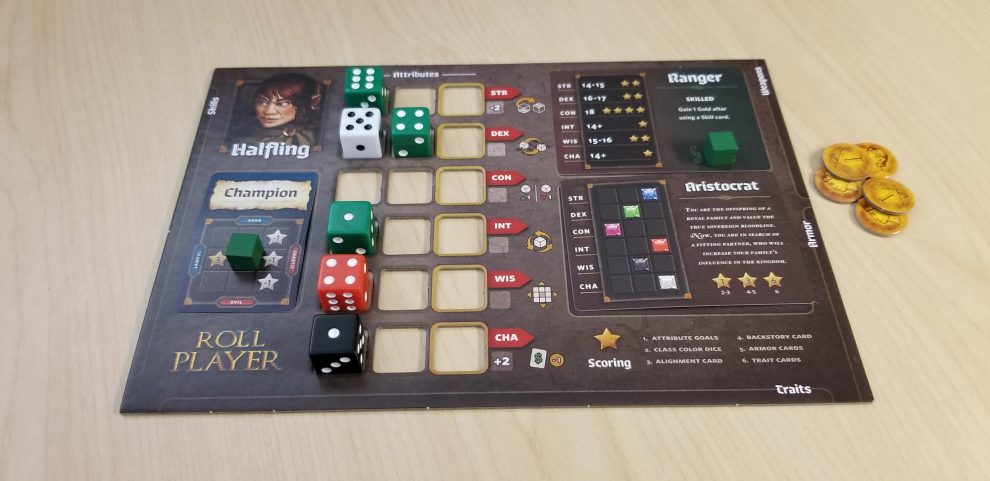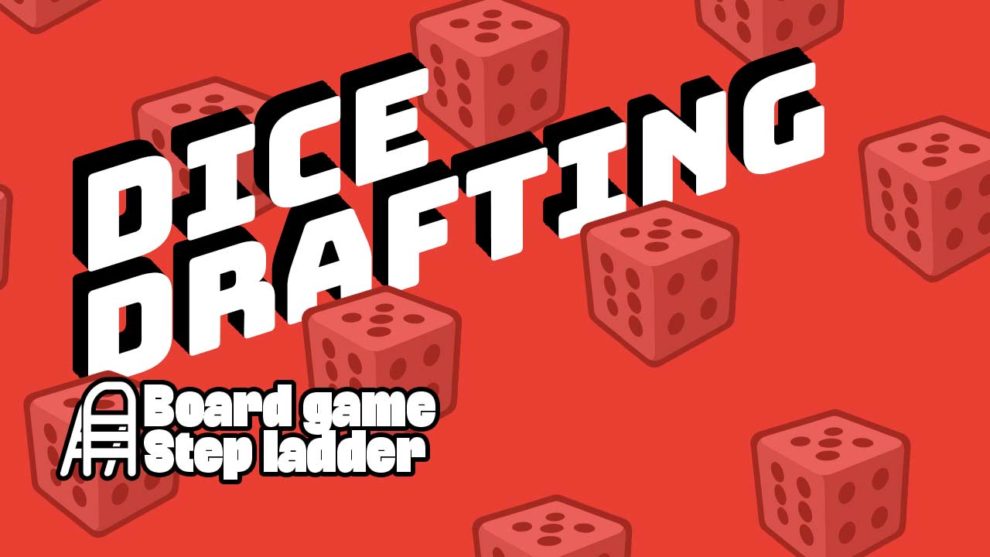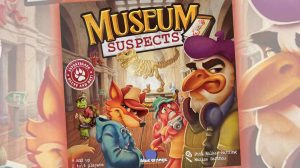Dice, those accursed cuboid purveyors of fate (unless they roll up in your favor, of course) are board game staples. They’ve been around a long time, some going back as far as 2800 to 2500 BCE, so it’s very unlikely they’re going to go away anytime soon.
For the longest time, when it came to board games, dice were used in a very limited array of boring ways: roll and move, in which the values of the dice determined how far along your game piece would progress around a board (Backgammon, Monopoly); roll and react, in which you’d roll a pool of dice and then do something else based on the results (Yahtzee); and roll for success, in which the results of the dice rolls would determine how successful you were at doing whatever you’d set out to do (Risk). It seemed we’d be stuck with these same tired mechanics for the remainder of time. There was no question: when it came to dice, board games were in a rut.
That all began to change with the advent of modern board gaming.
One of the new concepts introduced was dice drafting, the subject of this article. In dice drafting, a pool of dice is rolled together and then the players take turns choosing dice from that pool in order to do things. According to BGG, there are 117 games containing this dice drafting mechanism. The oldest game on that list is 2006’s Yspahan. So, if that is correct, I suppose we have Sébastien Pauchon to thank for relieving us of our dicey drudgery. Furthermore, if that is correct, I suppose we have him to thank in some part for today’s Step Ladder.
In today’s Board Game Step Ladder, we’re going to talk about games featuring dice drafting. The dice are still as deterministic as ever, but now there’s an added layer of choice.
Sagrada > Roll Player > Grand Austria Hotel
Sagrada
For many, their first introduction to the dice drafting mechanic will most likely be Sagrada, and with good reason: it’s a stellar game that’s not only an excellent introduction to this specific mechanic, but to modern board gaming in general. The game is easy to teach. The rules are easy to grasp. And, for many newer gamers, the gameplay is like nothing they’ve experienced before.
Sagrada puts the players into the shoes of artisans crafting the stained glass windows for the titular Sagrada Família basilica in Barcelona, Spain. As the game begins, each player has a window frame, empty but for the card that’s been slid into it. The frame is divided into a grid of squares, each of which depicts either a solid color or a pip value. The players will be competing to fill in their squares the most efficiently in order to garner the most victory points and win the game.
At the beginning of each round, a number of dice are drawn from the bag, rolled, and then placed within reach of all the players. Then, in turn order, each player will select one of the dice to place into their frame. Once everyone has selected a die, they will all take turns selecting a second die, in reverse turn order, and placing it.

Die placements follow some very easy rules: each colored square can only accommodate dice of the matching color, each square depicting a pip value can only accept a die with a matching value, white squares can accept anything, and dice with matching colors or numbers cannot be orthogonally adjacent to one another. But you’re not entirely beholden to the random whims of fate. Also included are several Tool cards which can be utilized, at a cost, to manipulate the dice if need be.
All this dice placement is in service to the Objective cards, a number of which are public and a few which are private. These reward the player points based on how well they were able to achieve the objectives shown on the card (having a particular arrangement of a certain color of dice or having a row where each die is a different color, for example).
Sagrada’s easy-to-understand rules coupled with its unmistakable visual appeal make it a great jumping on point for newer gamers. The challenging gameplay that lives within its interesting decision spaces ensures it’s just as pleasing for more experienced gamers as well. And the variability presented by the different cards, as well as the several expansions that have been released for the game in the ensuing years since its release, means there’s a lot to explore before it’s worn out its welcome.
Nice and light, it’s the perfect game to begin our Step Ladder. The next game on our list ramps things up a bit. Like Sagrada, you’re still drafting dice and you’re still filling in a grid. But, whereas in Sagrada, these are the only two mechanics at play, in Roll Player, they’re just two of many.
Roll Player
In my 2017 interview with its designer, Keith Matejka, Keith had this to say about Roll Player’s origins: “Roll Player is a dice manipulation game about making a character. That’s it. No adventuring, no quests. I focused on just one element of that experience and stayed true to that. It came from playing RPGs like D&D and video games like Skyrim. The core concept was “If Dominion is the metagame for Magic the Gathering, then what would the metagame for D&D be?””
As you can well imagine from having read that, in Roll Player the players are going to be using dice drafting in order to build characters for a fantasy RPG setting. During setup, each player is provided with a ‘character sheet’ that has been prepopulated with several cards which will determine things such as the character’s class (ranger, bard, etc.), its backstory, and its alignment. In between all of these sits the stats grid, empty but for a few dice that were randomly drawn, randomly distributed, and selectively placed during the game’s setup.
The character’s class card determines the player’s color (which is important in certain situations) and provides the player with a special ability that is unique to them. Additionally, this card dictates the target stat ranges the player will be trying to achieve during their dice placement. For instance, the Barbarian card states that if the character’s final Strength stat is 16 or 17, then its owner will score two points for that stat at the end of the game. The backstory cards provide similar goals. But, instead of looking for specific numeric ranges, the backstory cards look for specific colored dice to be placed in specific spots. The more dice placed in matching spots, the higher the player will score. Likewise, the alignment cards provide the players with even more opportunities to score points at the end of the game by means of manipulating the alignment cube that sits atop the card in an attempt to move it to a high scoring location by the game’s end.
The alignment cube is manipulated through the use of skill cards which, along with equipment and trait cards, are acquired from the central market. Skill cards, equipment cards, and trait cards provide the characters who are wielding them with unique benefits such as the ability to manipulate dice, end game scoring objectives, and even some set collection goals for more points.

At the heart of it all is the aforementioned market. At the start of each round, dice are drawn from the bag, rolled, and arranged across the market cards according to their pip values. Then players take turns selecting one of these dice to take into their possession, a tricky proposition. The lower valued dice are typically less desirable. However, selecting one of these will put you higher up in the turn order, while snatching a higher valued die will put you further back in the turn order. The dice in the middle come with some money, which is needed to buy cards from the market.
And turn order is a real consideration. Going earlier in the turn order means you get first dibs on whatever’s available in the market and it also means you’ll be the first to select your die in the following round. But turn order isn’t going to be your only consideration when drafting dice. You’ve also got to keep in mind your stat range goals. And, as if that weren’t enough, each die placed into a stat row will trigger a special stat-specific ability when it’s placed. Placing a die into the INT row, for instance, will allow you to pick up any one of the dice in your tableau and re-roll it.
And this is just a very high level overview of the game. If you’d like a more in-depth dive, you can check out our review of Roll Player. As you can well see, Roll Player is a significant step up in complexity from Sagrada, but it’s well worth the effort it takes to learn it.
The next game on our ladder turns things up even more. Gone are the personal dice tableaus. The dice drafting is still omnipresent, but in Grand Austria Hotel, you’re not drafting the dice to take into your possession. Instead, you’re drafting them in order to perform their associated action.
Grand Austria Hotel
In Grand Austria Hotel (GAH), the players are hotel owners competing to attract and provide room and board for the game’s various clientele. Over the course of the game, you’ll have several items that require your attention. Firstly, each guest needs a room, so you’ve got to make sure you’ve got rooms prepared. But, it’s not that simple. Each guest can only stay in certain colored rooms. So, that’s an extra consideration. And, just to further convolute what should be a relatively easy action, there are rules in place that prescribe what rooms are available to be prepared, when they can be prepared, and what bonuses preparing those rooms may provide.
Secondly, each guest likes certain things, so you’ve got to make certain you’ve got those things on hand. Once you acquire a guest card from the offering display, that guest will sit in your cafe until they’ve been given the items that they want (some wine and some strudel, for example) and there’s an empty room for them to occupy. And, if they’re still sitting in your cafe at the end of the game, they’ll cost you valuable points. That would be a shame, too, because each guest provides a unique ability whenever they exit the cafe to occupy a room.
Thirdly, you’re going to have to build your hotel’s staff. Acquiring these cards will provide you with some kind of benefit, whether it be a one time influx of goods, an ongoing ability that provides you with some sort of discount, or an end-of-game scoring bonus.
Fourth, there’s the Emperor you’ve got to keep in mind. The Emperor will be evaluating your hotel several times over the course of the game, and you’re going to want to make sure The Emperor is suitably impressed. Leaving a negative impression is going to cost you, whereas creating a positive one will gain you some kind of reward.
Lastly, there are the Prestige cards to consider. A random selection of these are drawn and set out at the beginning of the game. Each card dictates certain criteria that need to be met in order to score points from them. The first person to score one of these earns 15 points and folks scoring them later earn a lesser amount than those that have come before them.

All of these mechanics are tied together by, you guessed it, a dice drafting mechanic. At the start of each round, the pool of dice are rolled and then placed into the action locations, of which there are six, according to their value. On a player’s turn, they remove one of the dice and perform the action associated with the location from which it was removed. The more dice there are in that location when the die is removed, the stronger the action will be. Dice are removed in turn order, and then dice are removed once again in reverse turn order. So, each player will be removing a total of two dice each round. And, just to keep things fair, the first player will shift from one round to the next.
GAH has a lot of interconnected mechanisms that will have you trying to keep several plates spinning at any given time. There’s a lot you’ll need to get done, but there’s not a lot of time in which to do it. This keeps the pressure on from your very first turn to your last. Even though, on the face of it, the simple rules set and cheeky artwork from Klemen Franz might lead you to believe that GAH is a simple, lighthearted affair, it’s deceiving. GAH is a monster of a game to wrap your head around, but it’s well worth the effort. It’s not only a superb game, but it’s also an excellent example of what you can achieve with the dice drafting mechanic.
Did we miss anything? Would you have designed your Dice Drafting Step Ladder differently? Let us know in the comments. We want to know what you think!











Thanks again for these 🙂